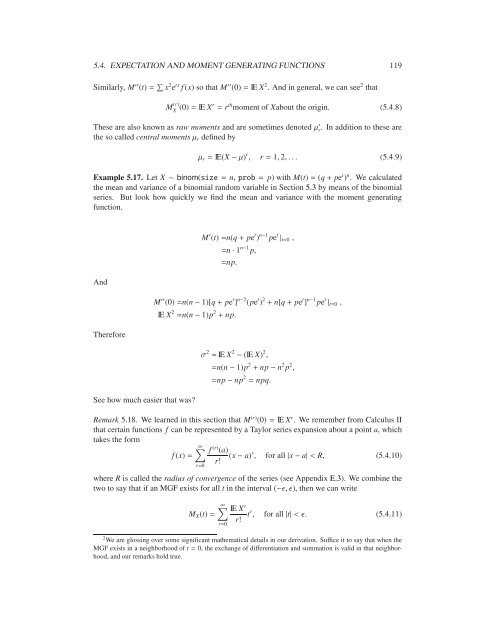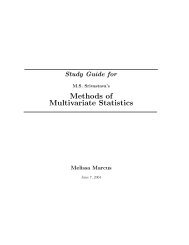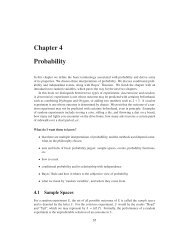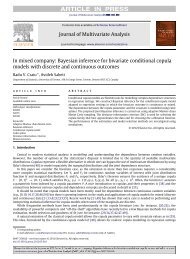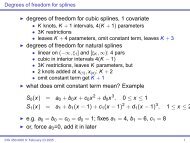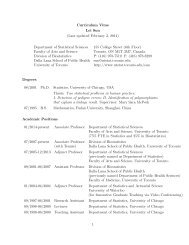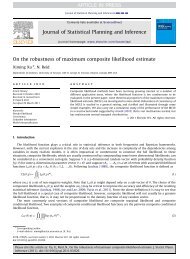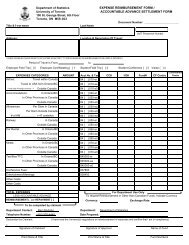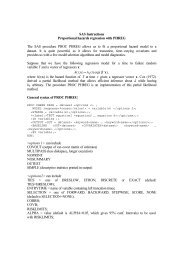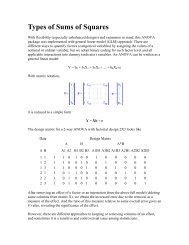Chapter 5 Discrete Distributions
Chapter 5 Discrete Distributions
Chapter 5 Discrete Distributions
You also want an ePaper? Increase the reach of your titles
YUMPU automatically turns print PDFs into web optimized ePapers that Google loves.
5.4. EXPECTATION AND MOMENT GENERATING FUNCTIONS 119<br />
Similarly, M ′′ (t) = ∑ x 2 e tx f (x)sothatM ′′ (0) = IE X 2 .Andingeneral,wecansee 2 that<br />
M (r)<br />
X (0) = IE Xr = r th moment of Xabout the origin. (5.4.8)<br />
These are also known as raw moments and are sometimes denoted µ ′ r.Inadditiontotheseare<br />
the so called central moments µ r defined by<br />
µ r = IE(X − µ) r , r = 1, 2,... (5.4.9)<br />
Example 5.17. Let X ∼ binom(size = n, prob = p)withM(t) = (q + pe t ) n .Wecalculated<br />
the mean and variance of a binomial random variable in Section 5.3 by means of the binomial<br />
series. But look how quickly we find the mean and variance with the moment generating<br />
function.<br />
And<br />
Therefore<br />
See how much easier that was<br />
M ′ (t) =n(q + pe t ) n−1 pe t | t=0 ,<br />
=n · 1 n−1 p,<br />
=np.<br />
M ′′ (0) =n(n − 1)[q + pe t ] n−2 (pe t ) 2 + n[q + pe t ] n−1 pe t | t=0 ,<br />
IE X 2 =n(n − 1)p 2 + np.<br />
σ 2 = IE X 2 − (IE X) 2 ,<br />
=n(n − 1)p 2 + np − n 2 p 2 ,<br />
=np − np 2 = npq.<br />
Remark 5.18. We learned in this section that M (r) (0) = IE X r .WerememberfromCalculusII<br />
that certain functions f can be represented by a Taylor series expansion about a point a, which<br />
takes the form<br />
∞∑ f (r) (a)<br />
f (x) = (x − a) r , for all |x − a| < R, (5.4.10)<br />
r!<br />
r=0<br />
where R is called the radius of convergence of the series (see Appendix E.3). We combine the<br />
two to say that if an MGF exists for all t in the interval (−ɛ, ɛ), then we can write<br />
M X (t) =<br />
∞∑ IE X r<br />
t r , for all |t| < ɛ. (5.4.11)<br />
r!<br />
r=0<br />
2 We are glossing over some significant mathematical details inourderivation.Suffice it to say that when the<br />
MGF exists in a neighborhood of t = 0, the exchange of differentiation and summation is valid in that neighborhood,<br />
and our remarks hold true.


